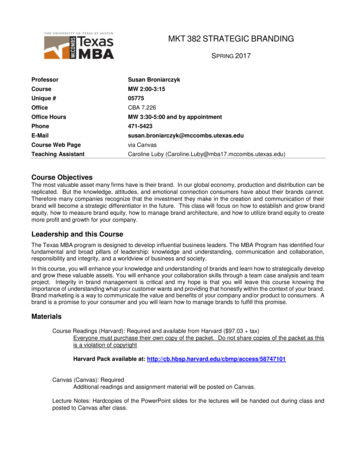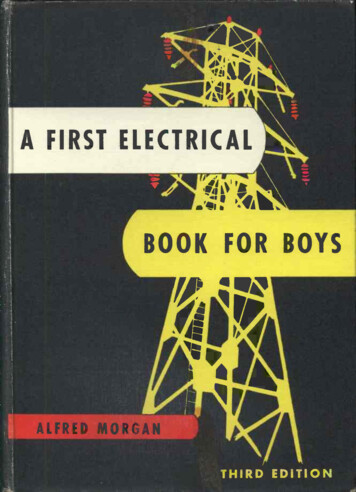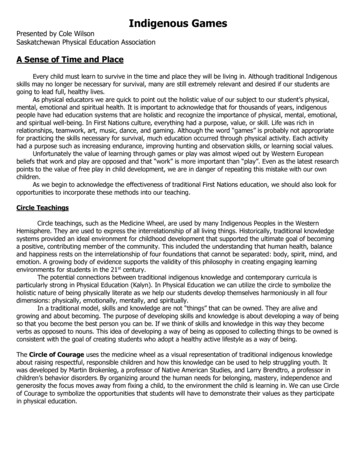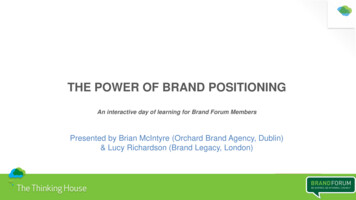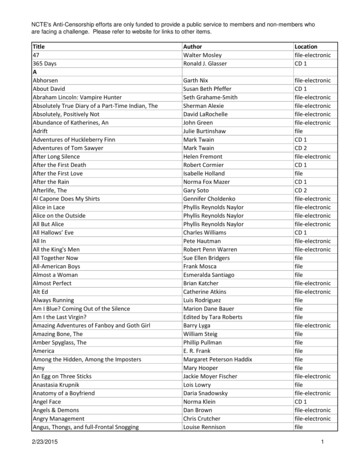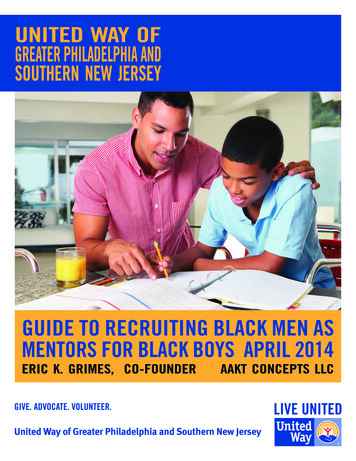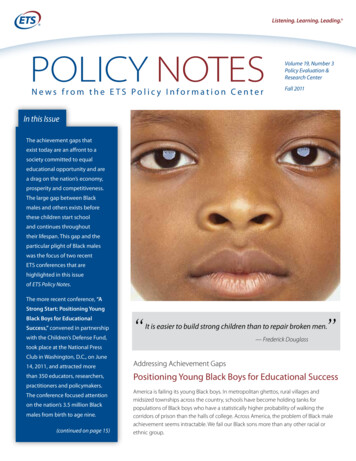
Transcription
POLICY NOTESNews from the ETS Policy Information CenterVolume 19, Number 3Policy Evaluation &Research CenterFall 2011In this IssueThe achievement gaps thatexist today are an affront to asociety committed to equaleducational opportunity and area drag on the nation’s economy,prosperity and competitiveness.The large gap between Blackmales and others exists beforethese children start schooland continues throughouttheir lifespan. This gap and theparticular plight of Black maleswas the focus of two recentETS conferences that arehighlighted in this issueof ETS Policy Notes.The more recent conference, “AStrong Start: Positioning YoungBlack Boys for EducationalSuccess,” convened in partnershipwith the Children’s Defense Fund,took place at the National PressClub in Washington, D.C., on June“ ”It is easier to build strong children than to repair broken men.— Frederick Douglass14, 2011, and attracted moreAddressing Achievement Gapsthan 350 educators, researchers,Positioning Young Black Boys for Educational Successpractitioners and policymakers.The conference focused attentionon the nation’s 3.5 million Blackmales from birth to age nine.(continued on page 15)America is failing its young Black boys. In metropolitan ghettos, rural villages andmidsized townships across the country, schools have become holding tanks forpopulations of Black boys who have a statistically higher probability of walking thecorridors of prison than the halls of college. Across America, the problem of Black maleachievement seems intractable. We fail our Black sons more than any other racial orethnic group.
The statistics are bleak.1 Nationally, graduation rates forBlack teens teeter just under 50 percent. And in manylarge, urban school districts, more than half of Black malesdrop out of school.Average Black male achievement falls far below that ofWhite and Asian boys. Only 12 percent of Black fourthgrade boys are proficient in reading, compared to 38percent of White boys. Only 12 percent of Black eighthgrade boys are proficient in math, compared to 44percent of White boys. By fourth grade, Black studentsmay be three full years behind their peers.2 “As we allowthis underclass to grow, our society and our democracyis at risk. That is not meant as an overstatement,” said ETSPresident and CEO Kurt Landgraf. “It really must be themost challenging problem in American public education.”“Children are suffering from a toxic cocktailof poverty, illiteracy, racial discriminationand massive incarceration that sentencespoor boys to dead-end and hopeless lives.”— Marian Wright EdelmanThe reasons for this are pervasive. “Children aresuffering from a toxic cocktail of poverty, illiteracy, racialdiscrimination and massive incarceration that sentencespoor boys to dead-end and hopeless lives,” assertedMarian Wright Edelman, president and founder ofthe Children’s Defense Fund (CDF). “It is a communitydisaster. A national disaster. Black boys are always at thebottom of the totem pole. We are here to change that.”“Our goal today is to examine the challenges facingyoung Black boys in America,” said Michael Nettles, SeniorVice President of the Policy Evaluation and ResearchCenter at ETS. “We want to consider ways to positionthis very vulnerable population for educational successas early as possible in their educational careers.”The story for American Black boys can have a differentending if society focuses its efforts on their education and2development, CDF’s Edelman advised. Working together,we can explore the challenges facing this populationand the opportunities to position young Black boys torealize their potential. “What is going on with our childrenis not an act of God, but of adult choice,” lamentedEdelman. “We can learn from what we know how to do.”Edelman addressed the conference “A Strong Start:Positioning Young Black Boys for Educational Success”in Washington, D.C., at the National Press Club, on June14, 2011. The conference, co-sponsored by ETS and CDF,attracted more than 350 educators, researchers andpolicymakers to confront the crisis faced by 3.5 millionBlack boys from birth to age nine, and to identify andhighlight programs that are making a difference.This is the second in a series of conferences that ETShas organized to look specifically at the Black maleachievement gap. The first, “Climbing the AcademicAchievement Ladder: Promoting the Success of BlackMales,” also covered in this issue of ETS Policy Notes,took place at ETS headquarters in Princeton, N.J., onNovember 13, 2010. ETS co-sponsored the eventwith the New Jersey Department of Education andwith support from the Metropolitan Center for UrbanEducation at NYU’s Steinhardt School of Culture,Education, and Human Development, and the Centerfor Effective School Practices at Rutgers University.This issue of ETS Policy Notes will weave togetherhighlights from both conferences, examining thestatus of Black males in America as well as the importantroles that families, schools, communities and publicpolicy can play in improving this status. All contributeto the perfect storm of educational and economicnegligence that society now must seek to counter.The focus begins with the earliest achievementgap noted at 9 months of age, and continues withinnovative programs that may alter the achievementtrajectory for these children. Finally, we will describean important initiative on which CDF and ETS arecollaborating that expands successful practice withETS’s support of a CDF Freedom School in Newark, N.J.1I n preparation for the June conference, data describing the rugged terrain that many Black males face during the course of their lives, from birththrough death, are presented in A Strong Start: Positioning Young Black Boys for Educational Success: A Statistical Profile. This publication is available athttp://www.ets.org/s/sponsored events/pdf/16818 BlackMale trifold3 WEB.pdf.2S haron Lewis et al., A Call for Change: The Social and Educational Factors Contributing to the Outcomes of Black Males in Urban Schools, Council of the GreatCity Schools, October 2010.
Education and the Family“Families are critical,” said Oscar Barbarin III, the HertzEndowed Chair in the Department of Psychology atTulane University. Families establish a home environmentand provide nurturing for children. Parents createconnectivity, Barbarin said, by exposing children to variedexperiences, expanding their knowledge and providingthe interpretive framework for their ongoing learning.“We recognize parents are the first teachers”, notedProfessor Vivian Gadsden, the William T. Carter Professorof Child Development and Education at the Universityof Pennsylvania, supporting Barbarin’s sentiments.“The most important factor in a child’s upbringing iswhether the child is brought up in a loving, healthy,supportive environment.”In the first five years of life, brain development occursfaster than at any other time. During these years, the brainis the most pliable, and vulnerable to influences. Therelationships that babies build with others and the worldaround them profoundly influence their development andlife trajectory.Complex skills build on these early, basic ones. “Anever-growing body of research tells us that executivefunctioning skills, or soft skills, like self regulation,persistence, motivation, confidence are just as importantfor school readiness as emerging cognitive skills,” saidRashanda Perryman, Senior Policy Associate with CDF.Soft skills are also predictive of academic success. Ifchildren have developed nurturing relationships, dynamiclanguage interactions, and have positive role models, theywill be set for school.Yet not all students are ready. We know that theachievement gap already exists when children startschool. But why? “When do disparities begin? Why doesthe gap emerge at all?” asked Iheoma Iruka, a researcherat the Frank Porter Graham Child Development Institute atthe University of North Carolina-Chapel Hill. According toher analysis of data from the Early Childhood LongitudinalStudy, a cognitive gap exists at 9 months of age, andwidens by 24 months. Thus, well before formal schoolingbegins, the Black child is behind, and by fifth grade, thatchild lags by nearly two full years. Astonishingly, a gapexists for Black boys of all income levels — regardlessof poverty. The trend in reading scores for all childrencompared with African-American boys is shown in Figure 1.Figure 1: Trends in Reading ScoresSource: Early Childhood Longitudinal Study, Kindergarten Class of 1998–99(ECLS-K)Of course, poverty exacerbates the problem. Childrenin single-mother households constitute the poorestdemographic group in America. Yet the percentageof Black babies born out of wedlock has continued torise, said Gadsden. From the late 1800s to the 1960s,close to 70 percent of Black children were born tomarried couples. According to the most recent data,71 percent of Black children are born out of wedlock.Aisha Ray, Senior Vice President for Academic Affairsand Dean of Faculty at the Erikson Institute, reports thatresearch shows powerful effects of poverty from birthto age 8, particularly in a few critical areas, like maternaldepression. When moms need to work more than onejob to meet financial obligations, not only are they oftendepressed, but time for children is squeezed. Readingto a child and being warm and responsive to his or herneeds all compete for time. Yet, this is an issue not onlyof maternal bonding, but of academic preparation.Children whose mothers are responsive are more likelyto actively engage in their environment, have longerattention spans, relate better to others, perseverewhen frustrated, have higher tolerance for frustrationand be less anxious themselves, said Dr. Ray. Theseare all factors for school success. Poor, young mothersin particular need help. They find it in Mississippi.The Mississippi Delta is “a snapshot of rural America,”cautioned the Reverend Anjohnette Gibbs, ProjectDirector for the Delta Early Learning Program (DELP),3
an evidence-based home-visiting program that supportsyoung mothers and teaches them how to care for theirbabies. Programs like this are urgently needed — morethan 50 percent of single moms in the region are poor.DELP provides in-home support for new mothersduring the first days and weeks after childbirth,connects new moms to resources and teaches themimportant skills like reading to their babies. Indeed,DELP is designed to strengthen the baby’s cognitivedevelopment in ways that will better prepare them forschool. Seventy-five percent of the infants in the programsshow that they function at or above level. Such workis important to Reverend Gibbs: “In 100 years, it won’tmatter if you drove a Cadillac or a Chevy. It will matterwhat we do for children. We consider a strong startpositioning young Black boys for educational success.”“In 100 years, it won’t matter if you drove a Cadillacor a Chevy. It will matter what we do for children.”background and skills, they may disengage, move awayand abdicate responsibility. Then, the cycle repeats itself.Children raised in fatherless families are more likely tohave lower test scores and to drop out of school.The Open Society Foundation’s Shawn Dove, ExecutiveDirector of the Campaign for Black Male Achievement,beat the odds. Raised by a “strong Jamaican single mother,”Dove admits he was the kind of youth one might hopeto reform. He was lucky. In junior high, when he adoptedthe herd mentality and wanted to follow friends on anon-academic path, his mother intervened. She refusedpermission for him to enroll in what Dove calls “MajorGym.” Resentment high, Dove enrolled in science prep.Dove uses the story to ask: “How do we engage andempower parents?” How do we increase the odds forthese children? According to Dove, we have many gapsto deal with besides the achievement gap. How do wedefy the issue of zip code? When we get communitiestogether to empower parents we will have a head start.— Reverend Anjohnette GibbsFathers matter, too. Gadsden’s National Center on Fathersand Families conducts research on how a father’s presencecan contribute to the economic and social well-beingof a child. The presence of the father has documentedpositive effects, maintained Gadsden. “Committed andresponsible fathering during a child’s infancy contributesto emotional security, curiosity, and math and verbalskills.” Too often poverty and underemployment thwartthe best intentions. Often, young Black fathers viewtheir role as a traditional protector and breadwinner.They describe a fatherhood that reflects mediainfluence, not personal experience, Gadsden added.Television may be one culprit. Compared with othergroups, African-American boys, on average, watchmore television — supplemented by video games. Theconsequences are confusion of what a man is supposedto be, said Barbarin. In unsupervised situations athome, they get premature independence. Often, theymust assume the role of man of the house and acceptautonomy without possessing the good judgment touse it. When they become fathers, lacking the necessary4“Committed and responsible fathering duringa child’s infancy contributes to emotionalsecurity, curiosity, and math and verbal skills.”— Vivian GadsdenGadsden’s Center has found that just about anyconstructive activity contributes positively to childdevelopment — especially reading to children, which isthe pathway to literacy. Taking walks together, countingobjects, and doing simple tasks at homes also contribute.Simply hugging children, giving them attention, andtelling them they can be successful can cause themto rise to the occasion, Gadsden emphasized.As CDF’s Edelman reminded us: “Children live up or downto our expectations.”Community and PovertyIn too many American communities today, thecircumstances caused by poverty and disadvantagesubsume the lives of young Black boys.
Consider these statistics:3 36 percent of Black children live in poverty 35 percent of Black children live in householdsdescribed as “food insecure” 38 percent of Black children live in householdswhere parents lack stable employment 13 percent of Black children have a mother withless than a high school education More than 75 percent of Black children bornbetween 1985 and 2000 grew up in “highdisadvantage” neighborhoods.“The fact that we are in the United States and parents arereporting insecurity about food is an issue of concern,”noted UNC’s Iruka. Children, particularly Black boys,who are born into poverty have less access to healthcare, go to lower-quality early childcare, attend inferiorneighborhood schools, and will probably live in poverty,observes CDF’s Perryman. Perhaps most distressing,according to Edelman, is that “a Black boy born in 2001 hasa one-in-three chance of going to prison in his lifetime.”In many areas, Black Americans are segregated inminority communities where children are more likelyto go to school with other children of color. Theimpact of racial, social and class stratification over alifetime can have devastating effects for Black boys,notes Ray. Racial segregation and the ideologiesthat support it help to spawn high levels of violence,poor mental and physical health, substance abuse,unemployment and underemployment. Segregationcan affect middle class Black boys, as well.When change does come, said Russlynn Ali, AssistantSecretary for Civil Rights at the U.S. Department ofEducation, it must come from communities andcommunity members, who together “will make theschools the hub of their community and the place to gowhere you can have a safe start and a healthy start and afair start and a moral start.”3Bremerton School District can boast one such communitysponsored program. Bremerton, Washington, is a smallcommunity with less than 5,000 students — really apocket of poverty in an affluent district. Their communitymodel was enacted with no additional funds. As SpecialPrograms Director for Bremerton, Linda Sullivan-Dudzic,announced, “If it can be done in Bremerton, it can bedone anywhere.”The original motivation to start a community-sponsoredprogram came when involved people realized that only4 percent of students entered kindergarten knowingalphabet letters. The group could have created a small,private pre-school to serve their own 30 studentsand serve their self-interest. Instead, they broughtcommunity partners together, examined the research,acted collectively, and now serve 800 students.After reviewing neuroscience research, the communityand the school district tried to answer two essentialquestions: What should children know and be ableto do? How do you best teach children? Their goalswere to increase the number of children enteringkindergarten with early reading and math skills, andto decrease learning difficulties for the students. Withbuy-in from the community, participating schools sharea common language, common goals and resources.Teachers engage in monthly professional developmentmeetings and remain part of an assessment loop.“Parents alone can’t do everything,” admonished CDF’sEdelman. “We have to get kids into strong early childhoodexperiences in the first three years of life.” Only then canwe assume children will be on the path to literacy. “Ifyou can’t read and compute and think in this culture,you are sentenced to social and economic death.”Many communities share Bremerton’s problems — fewshare the accomplishments. Washington, D.C., can boastone of the highest preschool enrollment rates in thecountry. But access does not spell success: Less than30 percent of D.C.’s programs meet accepted standardsof quality. Michela English, President and CEO of Fightfor Children, an independent nonprofit that focuseson quality early childhood programs, observed, “If we eferences for these statistics and related statistics can be found in A Strong Start: Positioning Young Black Boys for Educational Success: A Statistical ProfileRhttp://www.ets.org/s/sponsored events/pdf/16818 BlackMale trifold3 WEB.pdf5
do successful interventions early, we won’t have todo expensive ones later.” English sees this problemexacerbated by the fact that young parents often donot know how to choose a preschool program, otherthan by asking friends. Fight for Children is producinginformation and free videos to help teach youngfamilies what to look for in a preschool for their child.Quality and resources must go hand in hand. Educators inBremerton have combined resources and focused dollars“on what is needed to help the children.” Consequently,the number of children in strategic and intensive classeshas been significantly decreased, freeing Title 1 fundsto move down into preschool or up into high school.Children in Bremerton have made great strides and nowoutperform children from other school districts. WithinBremerton, children advanced from only 4 percent ofstudents being able to identify letters to 65 percent.But, Sullivan warned, “Strong pre-K is not sufficient. It iswasted if it is not supported by full-day kindergarten.”Revamped SchoolsThe need for a strong educational foundation is wellrecognized. “The development of high-quality, seamlesspre-K through grade three continuum programs” relieson research-based strategies for optimizing a child’searly cognitive and emotional development, saidJeanne Middleton-Hairston, National Director of theCDF Freedom Schools program. When implementedcorrectly, the pre-K through third grade continuummoves students smoothly from one grade to the next.“If we can get it right before age 8 or 9, if we givechildren a solid foundation, they’ll be on firmerfooting,” noted Kristie Kauerz, Program Director forpre-K–third grade at the Harvard Graduate Schoolof Education. The academic shift between learningto read and reading to learn happens right aroundgrade three, and students need solid skills by then.“We know how to fix this!” said Kauerz. “We know thathigh-quality preschool is important, [and that] high-qualityfull-day kindergarten has paid off tremendously. But fullday kindergarten is not a guarantee.” She added, “We needhigh-quality elementary schools, so skills do not drop off.”6Kauerz suggested that “there needs to be aligned qualityacross the curriculum.” A disconnect occurs when highquality programs are followed by programs that lackquality. “We are trying to offer superb pre-kindergarten,only to stick kids into a low-quality kindergarten program.”The Chicago Child Parent Center (CPC) is one exampleof an effective extended intervention. Students whoattended pre-K through grade three at CPC showedencouraging statistics: early achievement gains persistedin middle school, fewer children were retained, andfewer were relegated to special education. A new longterm study of the CPC program, published in the June2011 issue of Science, shows program effects continuethrough adulthood, resulting in lower incarcerationrates, higher marriage rates and higher income levels.During these critical early years, students developcognitive, communication and math skills, build socialand emotional competence, and establish patternsof engagement and learning. “What is so magicalabout ‘pre-K through third’ is that we are focusing onhorizontal alignment,” said Kauerz, by raising the qualityof each early grade to build a strong educational base.Meanwhile, through collaboration and support, theyare creating a ladder of learning, a vertical continuumthat results in a strong foundation for young children.After-School and SummerCommunity-based ProgramsKhary Lazarre-White is co-founder and Executive Directorof Brotherhood Sister Sol (BHSS), an out-of-school andsummer program in the Bronx. BHSS is an “evidencebased” model, said Lazarre-White, with emphasis onmorality and ethics. Eighty-five percent of their studentsgraduate from high school, as opposed to 24 percentin similarly troubled neighborhoods. While New YorkCity’s teen pregnancy rate is slightly below 10 percent,BHSS’s rate falls below 2 percent. And after 15 years inthe trenches, not a single member of BHSS is part of theprison complex. “We want all of our young people to goto college, to survive, graduate,” asserted Lazarre-White.“We believe in higher education, to learn what it meansto be strong men and leaders of their community.”
Though co-educational, they boast a single-genderfocus. Starting in 1995 with one brotherhood chapter,the essence of BHSS is to guide thinking and behavior onwhat it means to be a man. Youngsters start the programbetween the ages of six and twelve, and usually stay fourto six years. “They will write their own ethical and moralcode and revisit that every year and rewrite it,” explainedLazarre-White. “This is the code, this is how you’re goingto live your life. If you want to be a doc, go to med school.If you want to be a lawyer, go to law school. Where doyou go to learn how to be a young man? That ethos ofhow you live life is through every aspect of your life.”BHSS fulfills a concept the founders prized, that ofan alternate, stable home with discipline, guidanceand morals — skills most middle-class kids enjoy.The program tenets at BHSS surround support anddiscipline, smattered with doses of guidance and love.Discipline is taught as a means of inculcating personalresponsibility. In addition, staff is keen to accessstudent opportunities, like jobs and internships.“We need a Marshall Plan for education inthis country.”— Khary Lazzare-WhiteFinally, BHSS takes college seriously. Guidance iscomprehensive: Staff accompanies kids on collegeselection visits, and provide assistance to get in and staythere. Meanwhile, staff does what middle-class parentsdo when their kids get into trouble. “We defend themto the fullest extent of the law if they are arrested, andmake sure that isn’t a permanent part of the record.”With such a lopsided number of Black sons graduatingfrom high school, Lazarre-White wonders aloud why thereare not programs like this in every city in America. “On themacro level, we need a Marshall Plan for education in thiscountry,” declared Lazarre-White, who argues for the kindof money the affluent spend on their children. “Peopleargue for this or that school — it’s a waste of time. Whilewe have those arguments, hundreds of children fail.”4Progressive K–12 Schools for Black MaleAcademic AchievementToo often, the reality in America is that if you are poor,Black and male, you may need to win a lottery to get agood education. Educational lotteries exist across thestates. Without winning a lottery to get into a competitiveelementary school, the odds of graduating high schoolare less than 50 percent4, and the chances of readingbeyond an eighth-grade level, even if you graduate, arenot much better. Yet, if you win a lottery for a superbcharter or public school, your chances of graduating arecloser to 80 percent — at least, at one of the schoolsdescribed below. With luck, a Black youngster might justembrace the American dream. Is this the America we tout?Several examples of trendsetting, innovative programsfor transformational reform are highlighted below.Early Intervention and Early Education. ExcellenceBoys Charter School is a model for excellence. FoundingPrincipal Jabali Sawicki talks passionately about imbuinghis students with the message that they are collegebound — in kindergarten, from day one. What stepscreate that academic mindset? To start, teachers refer tostudents as scholars, homerooms bear university names,and after-school programs emphasize leadership skillsthrough activities that embrace the physical and literary,like athletic and Shakespeare clubs. More practically,school tutoring, Saturday programs and SummerAcademy are all available. But, the real key is literacy.Located in the Bedford-Stuyvesant community of Brooklyn,Excellence currently serves 395 boys in grades K–8. Sawickiexudes pure energy in talking about goals for success, andthe laudable commitment to make school joyful. Statisticsare encouraging. In 2009, in grade four, 90 percent ofstudents passed reading exams at Advanced or Proficientlevels; in grade five, 100 percent of students passedmath exams at Advanced and Proficient levels — placingExcellence among the top schools in New York City.“Schools are the critical lever to change the trajectoryof young boys,” Sawicki stated and he knows thatfor the lever to work, he needs more time. Studentsgo to school nine hours a day, about two hoursY es We Can: The 2010 Schott 50 State Report on Black Males in Public Education reveals that the overall 2007–2008 graduation rate for Black males in the U.S.was only 47 percent.7
longer than average. That time is devoted to books.“What allows us to be successful is the emphasis onliteracy.” Citing the crux of America’s problem withacademic achievement, Sawicki said, “Somethinghappens between third and fifth grade. At that point,school is dominated by text. If you get to that pointand you can’t read, you’ll only become frustrated.”When students put in practice time, they reap rewards.This is standard in music and sports — and logical forreading. At Excellence, teachers allot three and a halfhours a day to the reading core, including readingaloud, writing, comprehension, decoding and analysis.To bolster boys’ natural inclination to be part of a group,book groups abound, from Harry Potter to a hip hop club.Black male authors from the community regularly comein to read. Weekly, students stage a play on books theyhave read, all to foster the notion that “Reading is Cool!”The goal, maintained Sawicki, is to “elevate literacy to thehighest respect and adoration, teaching not just to readbut a love of reading.” Lastly, Excellence places emphasison ethics through a weekly community meeting.Sawicki structures his educational agenda aroundthree principles which he hopes have application forco-educational schools. He calls this framework the“Three Pillars of Excellence.”Three Pillars of Excellence1. Academics. Rigorous and challenging academicsform the foundation; students master literacyand computing.2. S tructure. High behavior standards become theexpectation; students need to be independentand creative thinkers, apt to succeed as theyadvance to other schools.3. E ngagement. Joy leads to engagement —Excellence calls it the the “J-Factor.” Schoolsneed to create delight, to become magicalplaces; educators need to make school “cool”while they channel boys’ abundant energiesinto productive pursuits.8Support through Middle and High School. EagleAcademy was created to provide high school boyswith a college preparatory education in the toughestneighborhood in the Bronx. Defying the status quo —and the conviction that boys’ schools were politicallyincorrect — Eagle Academy is the first all-boys’ publichigh school in New York City in three decades. Anyonecan get into Eagle; there are no requirements. But, achild must be lucky — it is available only by lottery.This school, like the best in the nation, is led by strongmorals and the belief in the potential of every child, saidDavid Banks, President of Eagle Academy Foundation.Eagle targets high-poverty communities with excessivelyhigh rates of incarceration: an Eagle Academy wasreplicated in Brooklyn to serve grades six through 12,and a third school in Newark, N.J. is planned for Fall2012 opening. Noting the startling statistic that justseven neighborhoods in New York City supply NewYork State prisons with 70 percent of their inmates,Banks hopes to disrupt the prison pipeline.The first precept of Eagle is comprehensive mentoring. Foryoung men growing up without fathers or a responsiblemale role model, mentoring is essential. Each student ispaired with an adult male mentor, inspiring one youngEagle student to coin the now-popular phrase: “A youngman without a mentor is like an explorer without a map.”As at Excellence, Eagle schedules more of a student’stime. The extra two hours per weekday and three orfour hours on Saturday yield 11 extra hours per weekand eight more weeks per year of learning. Engagingactivities
large, urban school districts, more than half of Black males drop out of school. Average Black male achievement falls far below that of White and Asian boys. Only 12 percent of Black fourth-grade boys are proficient in reading, compared to 38 percent of White boys. Only 12 percent of Black eighth-grade boys are proficient in math, compared to 44

